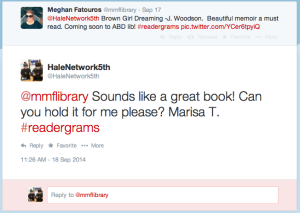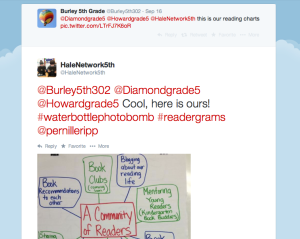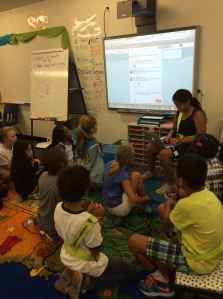1. READ ALOUDS: I first modeled how to tweet by tweeting about the book we are reading-aloud in class, Home of the Brave.
2. REAL AUTHORS: When we tweeted about our read-aloud, we tagged the author, Katherine Applegate (@kasauthor). Katherine happened to reply back to us that day and as you can imagine, my fifth graders wiggled and screamed with excitement. #Readergrams is a great way to connect with real authors.
2. BOOK TALKS: My students also submit book recommendations on sticky notes and we tweet these to other classes around the country. I introduced them to a few 3rd-5th grade classes I know via twitter and we tag them on our tweets. Our twitter community is gradually growing. Check out Tony Keefer's (@MkWyverns) and Kristin Ziemke's (@OurKidsTeach) kids who also share on Instagram!
3. LIBRARY CONNECTION: Our librarian, Meghan Fatouros (@mmflibrary), sent us a #readergrams about a book arriving soon to our school library. I thought this was a great way to stay connected with our library since we only get to go for 15 minutes each week.
4. CHART SHARE: Katie Muhtaris's 5th grade class (@Burley5th302) tweeted us photos of their reading charts. We happened to see it before our reading workshop began and their chart called "A Community of Readers" sparked such a huge conversation we ended up creating our own version of this chart. We tweeted this back to them and tagged it with #readergrams. It made me realize how great it would be for students to see anchor charts curated under #readergrams. What a great way to highlight the value of charts and give them a global audience!
5. EDITING SKILLS: About 95% of the tweets posted on our class twitter account is composed by my students. One student is the "tweeter" while everyone else act as editors. It makes me chuckle every time when I hear editors remind the "tweeter" to add a period or spell out "y-o-u" because saying "u" is not professional. ;)
6. WORD CHOICE: I am starting to love this 140 character limit. It has challenged my students to decide what words are worth using in a tweet. They are starting to realize that things can be said in multiple ways. I am also loving how this is helping my struggling readers with fluency and vocabulary!
7. READING RESPONSES: I will be introducing this one to my students this week now that we've learned a few ways to stop and jot. I would love to see readers share their post-its with other classes so that we can receive feedback or get ideas of other ways to respond to our reading. I would bet that if my students saw another class tweet a post-it where the student is using inference, my students would scramble to do the same in their own books.






